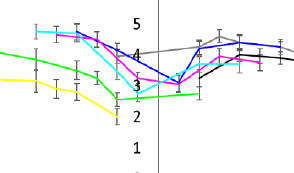
A psychophysical experiment was carried out to investigate visual comfort when reading on three OPPO Find X3s displays at three luminance levels (100, 250 and 500 cd/m2) at five illuminance levels (0, 10, 100, 500 and 1000 lx). Twenty young observers evaluated visual comfort using a 6-category points method. The results showed that observers felt most comfortable at the illuminance of 500 lx or display luminance of 500 cd/m2. There was an interaction between ambient illuminance and display luminance. High ambient light and display brightness levels provide a more pleasant visual experience. In low ambient light, however, the lower the brightness level, the more comfortable it is to see. Regarding the influence of background colour on visual comfort, the observers felt more comfortable having a grey background than white or black colour. When at dim illuminance, the background colour would have a great influence on visual comfort for negative contrast conditions, but when at higher illuminance, different background lightness levels had a great impact on visual comfort for positive contrast conditions. The above findings are very similar to the display luminance levels of 100 and 250 cd/m2.

There is a demand to display image on a transparent medium. If we can show image superimposed on a window, it can attract interest of people. However, a current achieved transparent displays show images only on the display surface, hence it is difficult to show image superimposed on an object that exists behind the screen. Thus, it doesn't understand intuitively. On the other hand, a display which can be perceived the image behind the screen should be placed inclined. Therefore, it is difficult to apply to advertising and exhibition. The purpose of this study is to generate transparent display to show image superimposed on near an object that exists behind the screen. We propose a display which shows image not on display surface but at a different image of depth. In this system, to show the image at behind the screen, display device is reflected on the transparent screen which incorporates a half mirror array. In this study, we use the mirror array as screen in order to locate the display device at an appropriate place. We optimize the surface of display device and angle of all mirrors so as to minimize the virtual image distortion. To confirm the practicality of the proposed method, we conducted a simulation. From the result, we confirmed the virtual image was able to display designated position.

The colors of Van Gogh’s landscape painting Field with Irises near Arles have changed considerably. To digitally reconstruct its original colors, we use an unprecedented broad scientific analysis and experimental art technological approach, by physically reconstructing oil paints of all pigments used by Van Gogh. We closely match the original paints, and for the first time determine all the optical properties involved. The investigation led to a digital image representing the original colors as good as possible.We found that for the digital color reconstruction it is important to take into account that museum lighting is often relatively dark in order to better preserve paintings. Since this affects the best way of representing the reconstructed colors on the display, we adapted the digital reconstructed image. We also corrected for the technical specifications of the electronic display on which the reconstructions will be displayed in the museum.Based on the reconstruction we conclude that the original colors in the painting used to be much brighter, and agreed much better with Van Gogh’s own description of the color composition of this painting. We show that unlike the current colors of the painting, the reconstructed colors are consistent with the color theories on which Van Gogh based his work.

Physico-realistic simulation of any type of display needs to take into account not only its emissive properties but also its reflective properties which can play a key role in outdoor situations for example. We discuss a method based on Fourier optics viewing angle instruments capable to measure the emissive properties of a display for quasi-all its viewing angle and also its reflective properties versus angle and wavelength very rapidly. More precisely the spectral BRDF of the display surface is measured at different incident angles with a good angular resolution to be able to simulate accurately the unwanted reflections that corrupt display contrast and color. Thanks to the angular dependence, the display aspect for an observer anywhere in front of it can be obtained rapidly for any color image and the impact of the different imperfections can be visualized and quantified. Same experimental data are use in a new generation of spectral ray tracing software. The ray-tracing accuracy is checked by simulations of color images and comparison to analytical calculation of the light emitted and reflected by each pixel of the display.